Garter cucumbers: methods and their features
Growing cucumbers, many summer residents direct their efforts to watering and feeding and simply forget about the garter. And in vain! After all, it is on this manipulation that the normal development of the bush, its illumination and susceptibility to disease depend.
What is worth knowing about tying cucumbers in the open field and in the greenhouse?
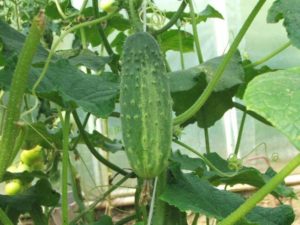
Content
Why you need to tie cucumbers: benefits
Many gardeners do not use any supports for growing, which allows the plant to spread freely along the ground. Despite the great popularity of this method, it is incorrect: curly lashes can be damaged, climbing on a nearby support, and the fruits hidden under the leaves can go unnoticed and overripe.
It is advisable to tie cucumbers for the following reasons:
- Cucumbers will take up much less free space, which will allow you to plant even more plants in the garden.
- Fruits hanging from the support are easier and faster to collect.In addition, it is almost impossible to damage plants.
- Stems and fruits that are not in contact with the ground are less susceptible to infection with crop-specific diseases.
- The plant throws out long shoots and forms more inflorescences, resulting in increased yield.
- It is much easier to care for a cultivated bed than for a heap of climbing stems.
- On well-lit plants, fruits form and pour faster.
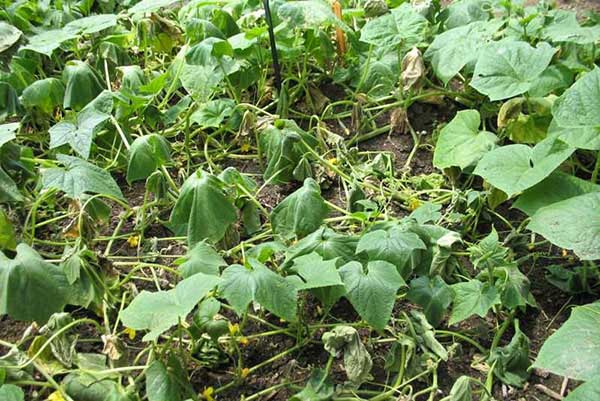
If you neglect the garter and leave the plant to creep along the ground, the bush quickly becomes thick, which increases the risk of fungal diseases, and the fruits are deformed and wrinkled.
General rules and recommendations for the correct garter of cucumbers
Cucumbers begin to tie up after they reach a length of 30-35 cm. At this time, the plant completely forms from 4 to 6 leaves. It is possible to carry out manipulation at an older age, but the risk of damage to curly stems increases significantly. It is recommended to perform the manipulation in the first half of the day, before the onset of extreme heat.
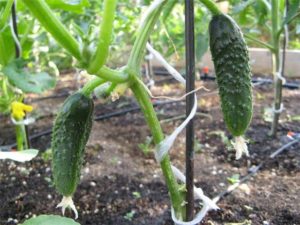
When tying a plant, you need to consider the following recommendations:
- In order not to damage the roots, as well as not to miss the optimal time for manipulation, the trellises are mounted in advance.
- It is undesirable to use thin ropes as a support material, since they bite into the stem under the influence of strong gusts of wind and severely damage it. To prevent this from happening, instead of ropes, it is best to use strips of fabric 2-4 cm wide.
- You need to fix the stem with a rope under the first or second leaf.
- When the crop is growing strongly, the long lateral processes must be tied to a separate rope, otherwise they will climb onto the main stem and entwine it, which can provoke minor injuries.
- If the stem has grown in length by more than 2 m and began to look out over the trellis, its top must be pinched. Without doing this, the top of the plant will continue to grow and oppress all lateral shoots.
Important! When performing a garter, do not tighten the fixing ropes around the stem.
Ways to tie cucumbers
In order to build a trellis for cucumbers, you will need 2 metal or wooden supports, fabric cotton strips, ropes and wire.
Contrary to popular misconception, it is not recommended to use nylon or nylon cuts for garters of plants, because after the formation of the fruit, the stems will slide off.
Instead of the last two materials, you can use coarse mesh, which are sold in specialized stores. For the construction of supports in greenhouses, special hooks are used, the purpose of which is to adjust the length of the twine.
Before installation, the bottom of wooden supports is treated with an antiseptic, and metal pipes are treated with special mixtures to protect against corrosion.
Video: do-it-yourself cucumber trellis
Important! It is necessary to install supports before sowing seeds, deepening the posts just in front of the garter, you can damage the root system.
After preparing the devices, you should decide on the type of garter. For garter cucumbers, the following methods are used:
Horizontal garter
Two metal tubes or wooden stakes are buried near the cucumbers. Several ropes are pulled between them at a distance of 25-30 cm. As they grow, the climbing stems will braid new tiers. As an additional support, several vertical ropes can be attached to the horizontal ropes.
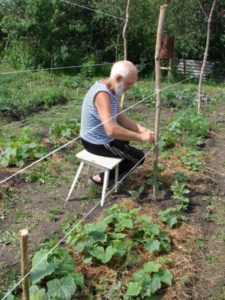
Due to the ease of installation, it is very simple and quick to build such a trellis. The main disadvantage of the horizontal method is that stems that have outgrown the support tilt downward and cast a shadow over the rest of the bush. To neutralize this feature, you need to build high trellises and neglect to pinch the tops. This method of binding cucumbers can be used both in the open field and in small greenhouses.
Vertical garter
By analogy with the previous method, 2 supports are driven into the soil near the cucumbers. Then one rope is pulled at the top between the posts and other ropes are tied to it, the number of which is equal to the number of stems that need to be tied. The ends of the plants are neatly tied to a hanging rope. This method is very convenient for tying a large number of cucumbers. The vertical method of garter cucumbers is used both in the open field and in the greenhouse. 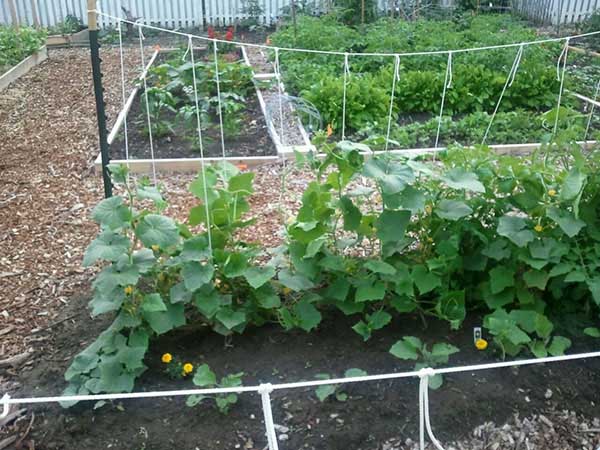
There is another version of the vertical method: instead of a U-shaped structure, a small peg or twig is driven in near each plant and the plant is tied to it. This method is used for garters of tomatoes and cucumbers.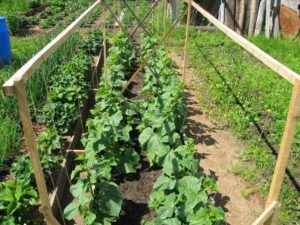
Cucumbers growing tilted or upward receive a lot of light and are less prone to mechanical damage.
Other (unusual) ways
If the cucumbers were planted in a circle, several supports are installed around them, thus forming a pyramid. The posts are connected at the top point at an angle of 65-70 degrees. The structure is installed in the middle of the garden bed. You can tie up 10-20 plants at a time in this way.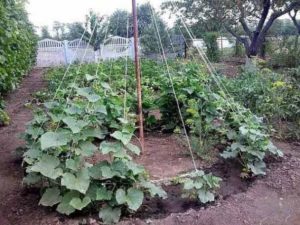
According to the second hybrid method of garter cucumbers, a metal pipe 3 m high is driven into the center of the bushes planted in a circle.Then long ropes are wrapped around its top. After tying the stems, the shape of the structure resembles a Christmas tree. Such structures not only contribute to the normal growth of plants, but also give an aesthetic appearance to the summer cottage.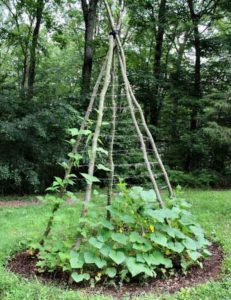 Garter on the net. You can also tie up cucumbers using a plastic coarse mesh, which is attached to 2 supports. To prevent sagging of the material, on long beds, several more posts are driven into the ground as additional support. Some gardeners make a net for garters for cucumbers from thin wooden planks or metal rods. Such support combines horizontal and vertical methods at the same time.
Garter on the net. You can also tie up cucumbers using a plastic coarse mesh, which is attached to 2 supports. To prevent sagging of the material, on long beds, several more posts are driven into the ground as additional support. Some gardeners make a net for garters for cucumbers from thin wooden planks or metal rods. Such support combines horizontal and vertical methods at the same time.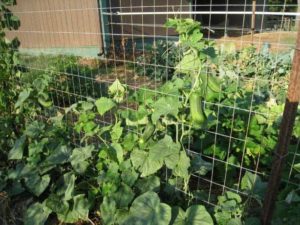
Please note that fine-mesh nets cannot be used to implement this method, as they interfere with the normal development of leaves and fruits.
Some gardeners practice cucumber garteron an arc-shaped trellis. For the construction of such a structure, on both sides of the row in which the cucumbers are planted, wooden rods are buried in the ground and the ropes are pulled between them. The stems are attached to ropes, and they gradually wrap around the trellis.
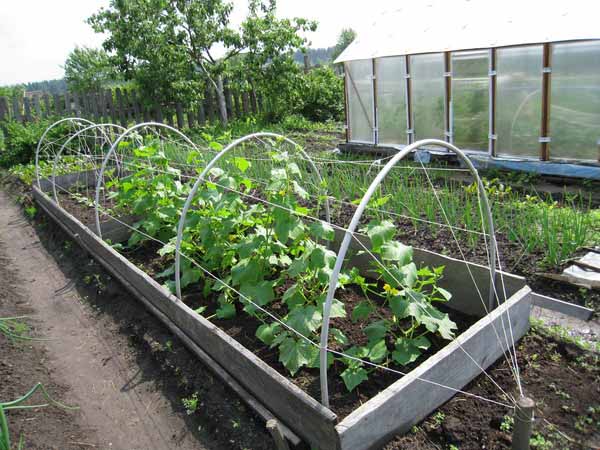
There are also summer residents who assign the functions of a tapestry to the fence that encloses the site. In this case, the cucumbers are planted along the fence, thereby allowing the culture to climb the makeshift trellis.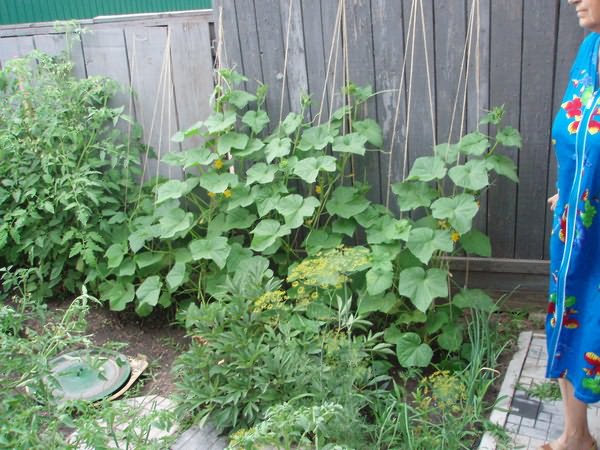
As an alternative to the trellis, the cucumbers are planted in a high barrel. As they grow, the stems are pulled out of the container and hang down freely. The advantage of this method is that for sowing cucumbers you do not need a lot of space and there is no need to mount a trellis.
By the way! About, how to grow cucumbers in barrels - read in this article!
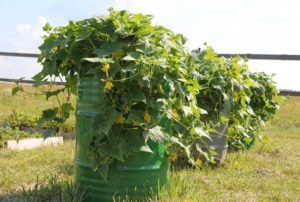
Important! To reduce the risk of damage to the stems and to be able to control the tension of the strings, sliding loops are made at their ends.
Video: how to tie up cucumbers in the open field
Features of the garter of cucumbers in the greenhouse
If the purpose of an outdoor garter is to minimize contact of the fruit with the ground and facilitate harvesting, then a cucumber garterin the greenhouse has owning goals:
- Bushes growing vertically receive a lot of sunlight, which is very important when grown indoors.
- Plants do not intertwine with each other, and mold does not start in them, which causes rotting of the fruit.
- Thanks to this arrangement, the side shoots are better formed, and the plant is easily pollinated.
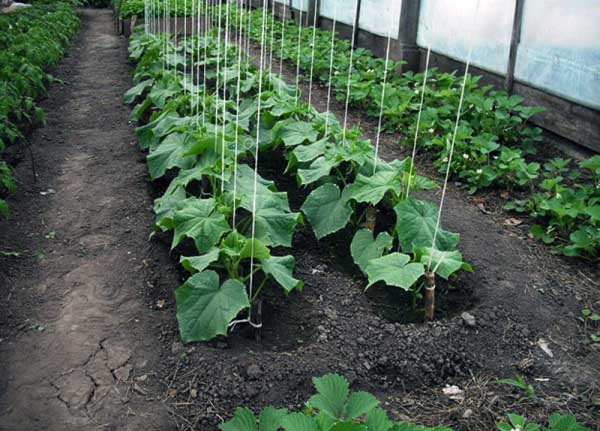
In addition to the above, the following methods are used to tie cucumbers in open ground and in greenhouses:
- "Blindness". To prevent too strong growth of the bush to the sides, the central stem is attached to the support, and the lateral shoots located more than half a meter in height are removed. With this pruning, all nutrients are directed to the fruit formation on the main shoot.
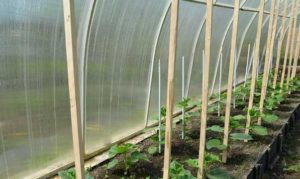
- V-shaped garter. A mesh net or a pair of ropes is attached to the upper part of the greenhouse and erected to the sides. When using a mesh, the antennae simply cling to the material. Using twines as a garter, the ends of the stems are alternately attached to them.
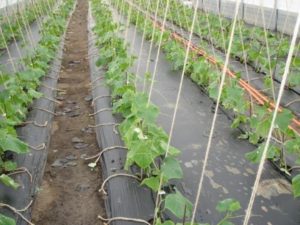
The main advantage of both garter methods is that the cucumber bushes placed in this way do not shade each other, as a result of which they practically do not get sick and bear fruit better.
Video: how to tie cucumbers in a greenhouse
A gardener looking to harvest a good crop of crispy cucumbers should definitely take the time to tie the plant up. The simplest manipulation can improve the condition of the crop and increase its yield. In addition, an intricate design, braided with green stems, will be a wonderful decoration for a summer cottage.

